I’ll start by saying that my observations are based on our limited time and limited number of places we were able to visit in both capitals – Zagreb, Croatia and Budapest, Hungary.
It’s interesting how some places seem to really energize me, while others, not so much. It’s hard to tell how much this feeling is due to the place itself, and how much of it is related to other factors like the weather, the sequence in which we’re seeing things, my expectations coming in, or just my level of energy at that time.
Other peoples’ comparisons and opinions will surely be different from mine. And I wouldn’t be surprised if we’d visited these cities in different times of the year or in a different sequence, my comparisons would’ve looked different too! But I wanted to share how I saw them at the time.
First, I’ll share a little bit about each city and what we did there, then some comparisons that lead to my experimental city rating system.
Zagreb
Zagreb was our 5th and final main stop in Croatia. It’s the biggest city in Croatia, so I knew it’d have a different flavor than the other places we’d stayed and visited along the Dalmatian Coast. Like the other Croatian towns we stayed in, it had an old town, a fortress, and apparently the world’s shortest funicular (we passed on tickets and took the stairs instead). It had a unique cathedral, some beautiful architecture, and the largest farmers market we’ve seen to date with a large fruit and veg area outside and flower stalls leading up to it. Then, downstairs were the meats, cheeses, bread, and dairy sections.
Zagreb has a crazy number of museums, something like 47, some of which seem like a bit of a stretch. The museum of chocolate, for example. Why would that be in Croatia? Or the Museum of Mushrooms? Um, no. The Museum of Broken Relationships, was actually quite good, highlighting objects relating to stories both funny and heartbreaking. But the Museum of Hangovers and the Museum of Cannabis? We passed on those. And then there was the 80’s Museum – boy did that make me feel old! We did really enjoy the Museum of Naïve Art, though, featuring the works of artists who had no formal training. It was pretty inspiring.
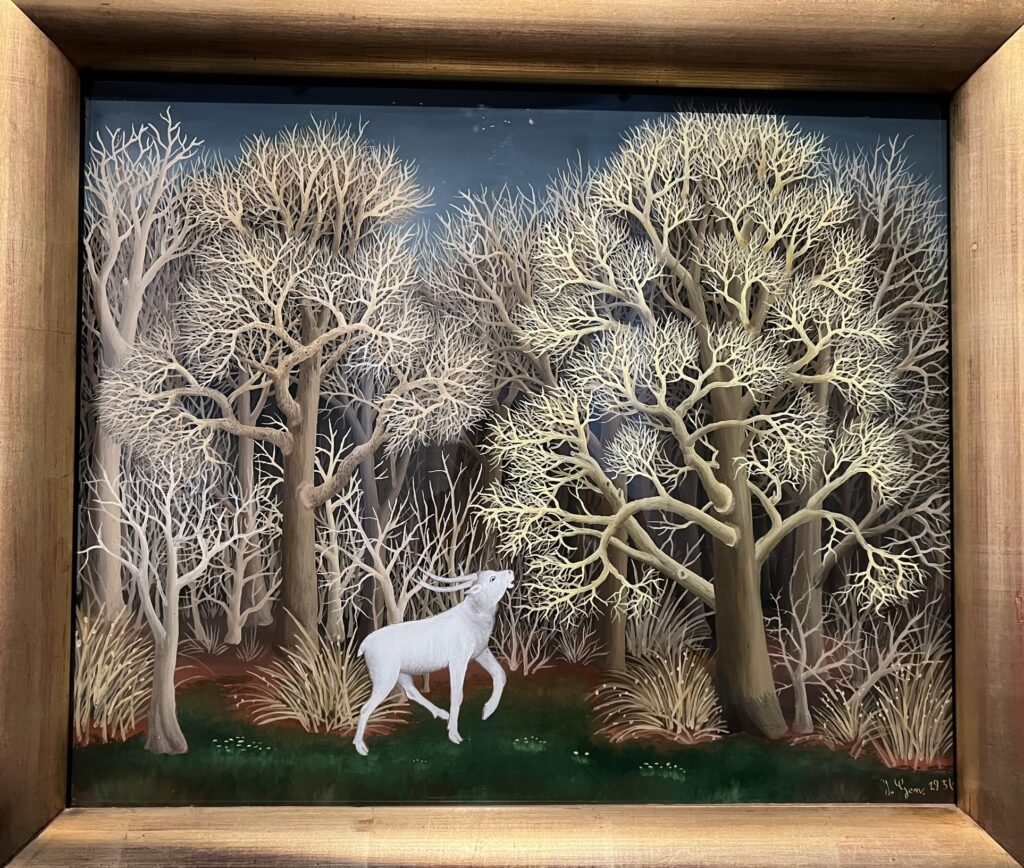
We stayed in a small, but very fresh and modern guest apartment with big windows looking directly out onto the stately dome of a big cathedral. Blue trams ran up and down the main streets providing an easy way to get around after our feet had had enough. We had a good time just walking and exploring the main sites and checking out restaurants that were recommended by Rick Steves and our Bolt driver. The weather was cloudy and cool so both sweatshirt and denim jacket were needed most days, which I wasn’t expecting for June in that part of the world. Everything was good, but I just wasn’t feeling it for some reason. I hoped I wasn’t burning out of travel already!
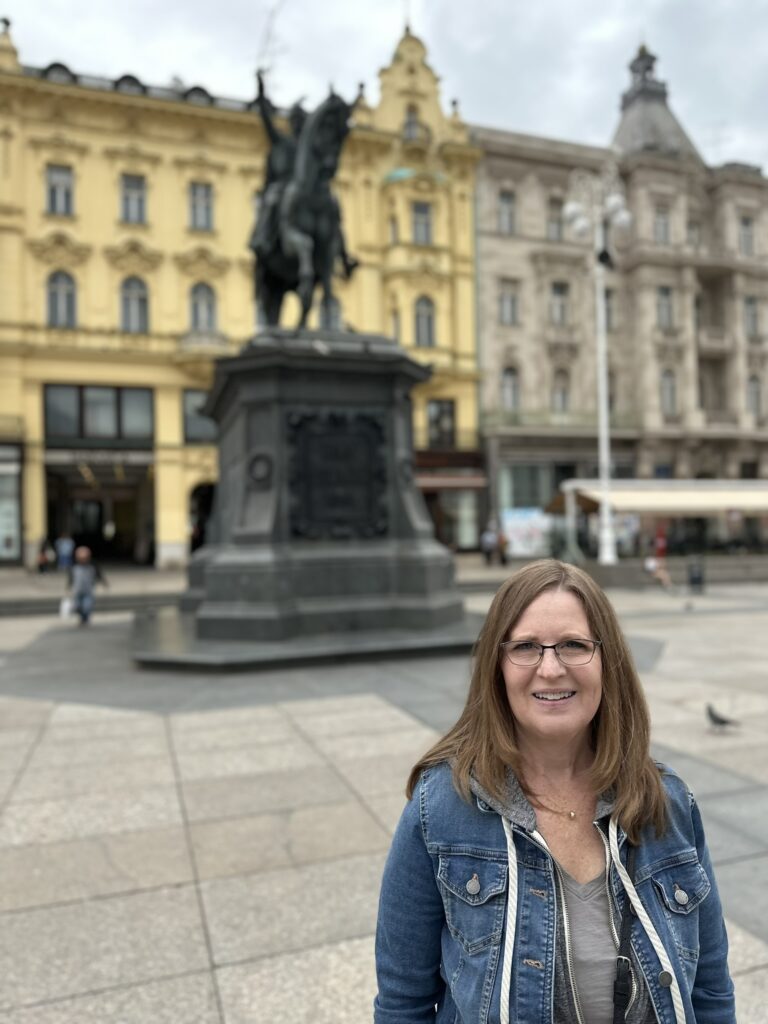
Budapest
After four nights in Zagreb, we took the bus to Budapest. We hadn’t originally planned to go to Hungary during this phase of Our Big Adventure, but added Budapest when we saw it would make a convenient stopover on our way to Romania.
As soon as we arrived, looking out the window of the Bolt on the drive from the bus station to our home exchange, my spirits lifted. It was sunny and warm! And I caught glimpses of amazing old buildings I was excited to explore. There were leafy, tree-lined streets and residential neighborhoods with hanging baskets. Rather than simply sights to look at, there seemed to be lots to do – free concerts, thermal baths, and river tours, in addition to museums, of course.
Budapest is more than double the size in population than Zagreb. And right away we noticed it also has a much more diverse population in terms of ethnicity and body shapes and sizes. It felt much more cosmopolitan. But with the size came more noise and seemingly endless sirens.
Our first day
We had a pretty perfect first day. After getting settled into our lovely home exchange apartment, we headed out to explore. Our first afternoon in a new city, we like to wander around without an agenda to get the feel of the new place. We started at one of the restaurants our host recommended and had a wonderful meal. We started by sharing a bowl of cold sour cherry and beet soup topped with a drizzle of yogurt (amazing), then I had a spicy beef goulash with puff pastry on top while Ivan enjoyed pulled lamb over pilaf. For dessert, we shared a huge coconut rice pudding for two that came with four toppings – toasted almonds, halva crumbles, raspberry coulis, and sumac. Wow – all delicious!
From dinner, we wandered over to the Parliament building. It was a stunner! We had a blast taking pictures of it. From there we could see the Chain Bridge over the Danube so we walked to check that out and ended up crossing to the other side to get views of Parliament from better light. We kept walking down along the western shore where, around every corner, there were more beautiful structures to catch our attention. It was as if they were competing with one another!
We continued along until we crossed the Margit Bridge back to the Pest side. The bridge passed over an island where our curiosity led us into a huge park with lots of grass, shade trees, flower beds, and a musical dancing fountain. We sat and watched with big smiles on our faces for song after song. It felt so nice to be there enjoying the entertainment on a warm evening with everyone else. A perfect ending to a wonderful first day in Budapest.
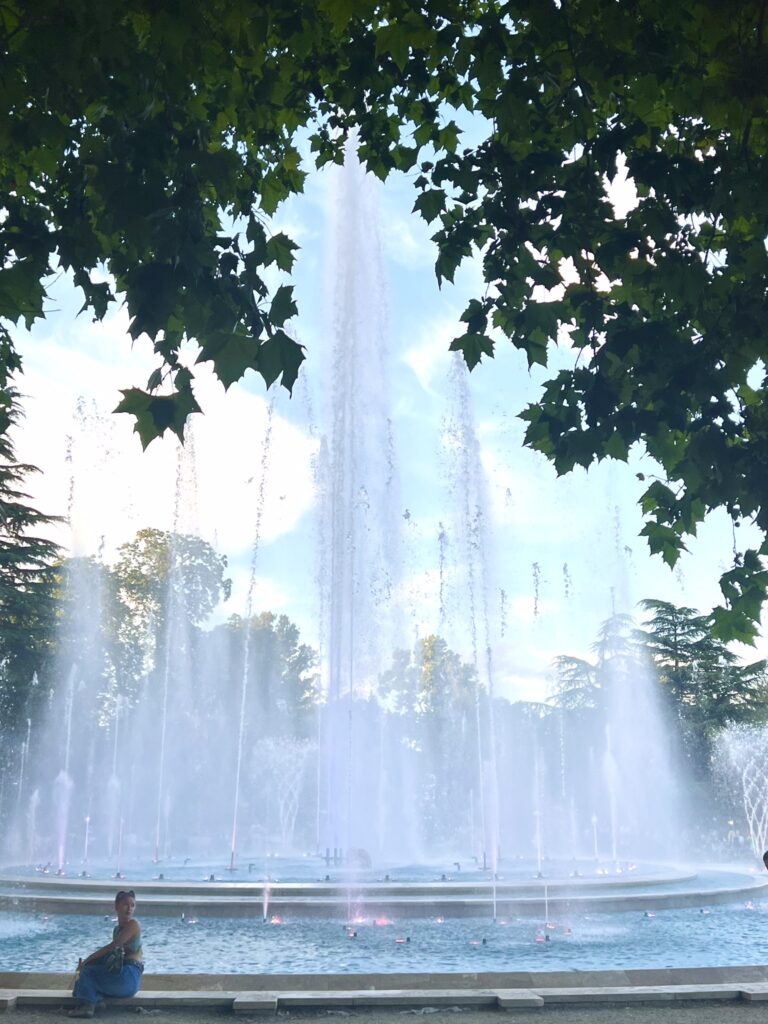
But then . . .
Being that this is ‘Real’ World Travels, it’s only fair to share our not-so-fantastic second day. It started with the stress of having a lot of things we wanted to do, but not really knowing where to start, how long it would take to get from one place to the next, or the best way to get there. And after buying the 2-day Budapest pass, I also felt pressure to make the most of it, but only realized after we bought it that, although it had a long list of free and discounted activities, none of the things from the top of our wish list were covered. So, we needed to decide how to best balance making the most of the pass (not feel like we wasted our money) versus spending more money and doing what we really wanted to do.
We came up with a plan, but things didn’t exactly go quite as we’d hoped. For example, we walked to the Buda side of town to check out Buda Castle and St Mathias Church. It was a long walk, and it was hot, and when we got there, we learned the funicular up to those sights was broken down, so we had to walk up. Once we got up, we thought we could take advantage of the Budapest pass by taking the little train that goes around to the main sights. Well, that turned out to be a bit of a joke. People practically tackled us to try to get on before we did so we couldn’t sit together. But no matter, it only took us a few blocks and then stopped due to a motorcade of dignitaries, and we had to walk the rest of the way anyway.
From there, we went back to the Pest side of town. We’d planned to take public transport since we’d already walked a ton, but because we couldn’t easily find the station, we ended up walking all the way back. St Stephen’s Basilica was beautiful, no doubt, and we planned to take advantage of the free concert inside that evening. But, we found out the concert wasn’t exactly free because we still needed to buy tickets to get inside the Basilia.
While we waited for the concert, we climbed flight after flight of hot, sweaty stairs to get to a crowded narrow lookout where we had to squeeze past all of the other hot sweaty people to make our way around the dome for a few just OK pictures. Then, the concert turned out to be just an organ and a cello who played only one recognizable melody. The rest were very heavy and dark, and sure didn’t do anything to lighten my mood.
Then, we were on to an only so-so dinner. I was excited about the dessert at least, though. But with one bite, it was clear it had walnuts because I started to have an allergic reaction. That was it. I was done! I guess the good news is that we got in 30,000 steps that day. And, that the following days were much better! A few hightlights:
Thermal baths
We had an amazing time at the Széchenyi Thermal Baths. We were told it’s a must-do when in Budapest, and I wholeheartedly agree. Although there were several hot and cold pools and sauna options inside, we spent most of our time in the two biggest baths outside since it was a beautiful sunny day. One was a warm swimming-pool temperature, and the other was warmer, but not quite hot tub hot. Yes, there were a lot of people there, but it didn’t affect our level of enjoyment. To the contrary, it was fun to be enjoying the water with them.
My favorite part was, for lack of a better term, a whirligig in the middle of one of the pools that pushed you around in a circle. When you got close to it, it would kind of suck you into the flow and around and around you’d go until you maneuvered to spit yourself out. There was not a single person in the flow without a big smile on their face. It really brought out the kid in all of us. Just pure fun!
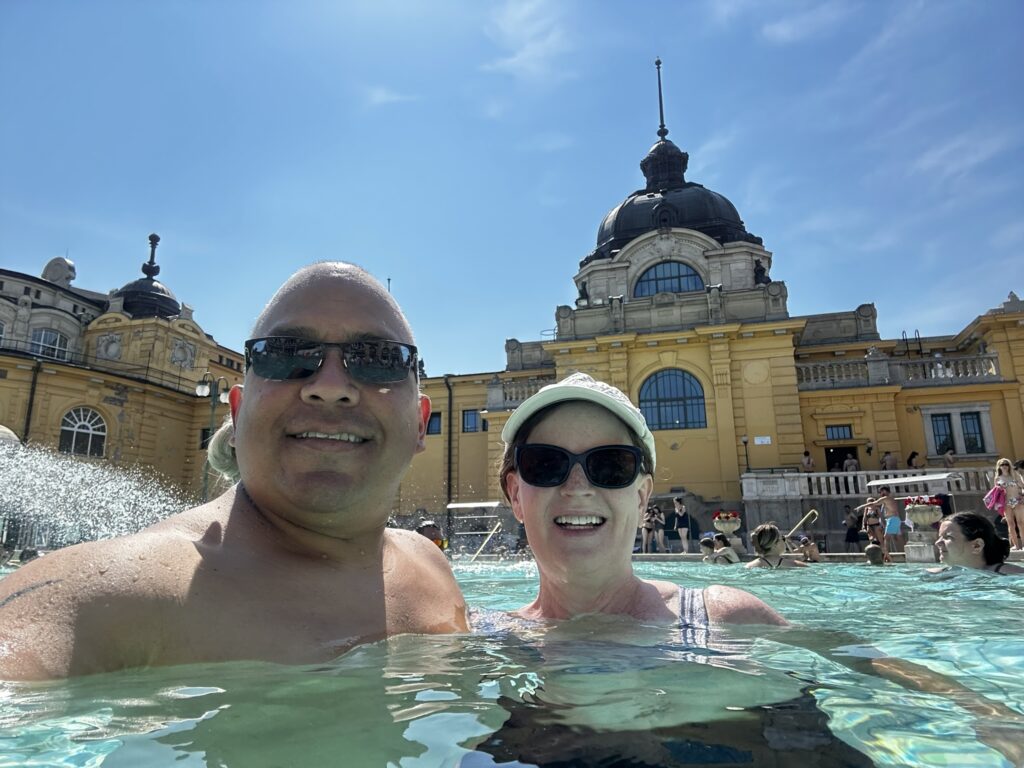
Night cruise
This is a case where I’m glad we didn’t go with the “free” daytime cruise included in our Budapest pass and decided to buy tickets to the night cruise instead. In a word, it was magical. A warm June evening, sitting on the top deck of the tour boat. It only had two single rows of chairs on the upper deck so everyone had a “window” seat, as well as a set of headphones to listen to the narration about the landmarks as we floated past them. And as amazing these buildings were during the day, lit up at night they were just spectacular.
History lessons
Other highlights of Budapest brought up strong emotions of a completely different nature. They were poignant lessons for us about horrors of the past. There were the bronzed shoes by the shore of the Danube that served as a memorial to the Jews who were ordered to take off their shoes (which could be re-sold) and massacred at the edge of the water so their bodies were carried away.
We had a brief tour of the Dohany Street Synagogue, the largest Synagogue in Europe where we learned how the Jewish Quarter came about and how the Synagogue served as a shelter for hundreds of Jews during WWII.
And our last grim lesson came at the House of Terror museum which laid out two tragic eras in Hungarian history. First, when they were under the control of the Arrow Cross supported by German Nazis, and then by communists backed by the Soviet Union. The museum laid out what the average Hungarian’s life looked during those times and what they had to endure. It was a very creepy feeling to be in the very building that was the headquarters for both regimes in Hungary.
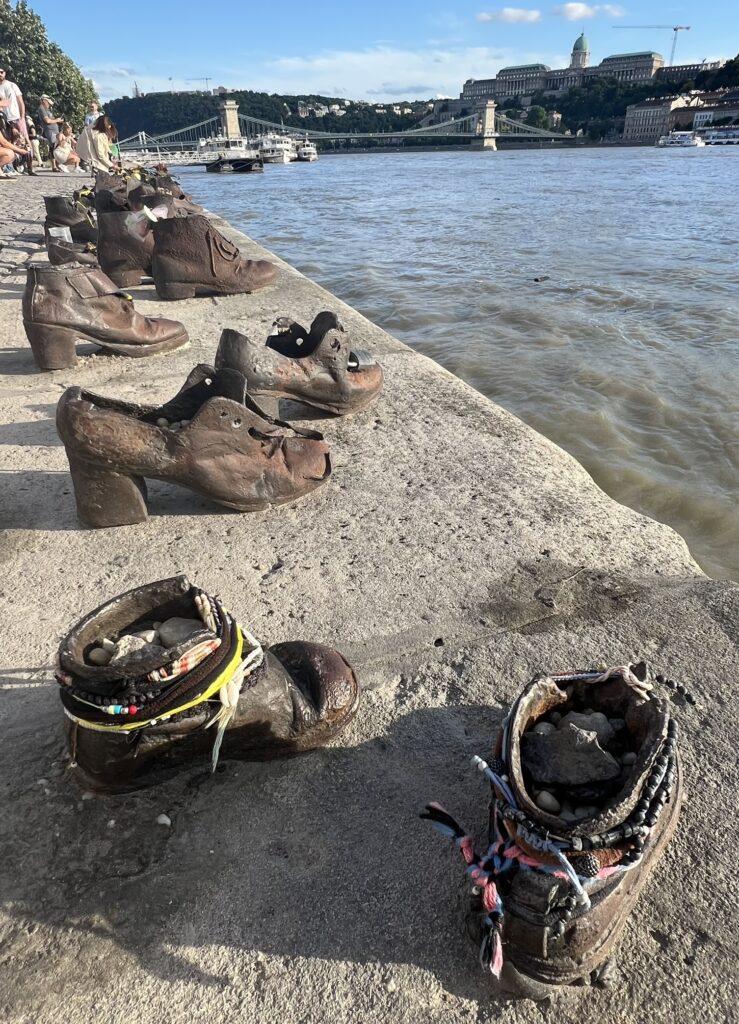
Zagreb vs Budapest
Thinking about the different emotions and responses I had in Zagreb and Budapest led me to ponder on what, to me, makes up a great city/town. I landed on the following five elements that I score on a scale of 0 (the element doesn’t really exist in a meaningful way) to 3 (highest score). I felt a little badly giving ratings, but then remembered how even my travel writing hero, Rick Steves, does something similar with his one to three triangle ratings (we affectionately call them Rickies).
I may end up refining my categories or scoring system as I continue to test it out, but meanwhile, but here’s my completely unscientific, 100% subjective, singular assessment.
Nature – parks, natural areas, birdlife
We found one really nice park in Zagreb, and there were some nicely maintained flower beds around some of its landmark buildings, but there was minimal greenery in the main square or streets in old town or downtown. Budapest, as mentioned earlier, had lots of mature, green, street trees. We also happened upon several large parks, one of which was the island with the dancing fountain.
Water – rivers, lakes, ocean, or even plenty of fountains or water features. Yes, one could argue that water should be considered part of nature, but to me it’s important enough to merit its own category
Zagreb is inland and does not border any rivers or lakes, nor did I see many water features. Budapest has lots of water in the form of the Danube River. The Danube itself isn’t much to look at. It’s slow-moving, olive-greenish brown with no signs of aquatic life in it or around it. But, you can easily walk for miles along the shore and there is beautiful architecture on either side and stylish bridges to admire. And did I mention the dancing fountains?
People Connections – interactions, large and small, that give us that warm feeling. This rating is more about how well we did at connecting, it’s not a rating of the people themselves!
We found the people in Zagreb to be similar to other parts of Croatia – cordial and rather reserved, at least at first. So it took a bit of work for us, as introverts, to make connections.
Meanwhile, in the opinion of our Hungarian Bolt driver who vacations in Croatia, Croatians are very friendly, but Hungarians are crazy. We asked him if what we’d heard was true, that Hungarians don’t smile much and it’s not a good idea to smile at strangers. He said he was too close to have an objective opinion. But he did share that just within the last day, he’d had one fare who, on his way to the airport to leave town, told him that he, the driver, was the first person in Hungary who had smiled at him, while another fare had told him that the best thing about Hungary was the friendly people.
We got a bit of a mixed bag in Budapest. Plenty of folks were friendly enough, but we did have one security guard who, when asked a question, briskly told us to “read the sign”, and a lady who condescendingly showed us which way left was by grabbing her wrist and saying “this is left”. Others pretended we weren’t standing at the counter trying to buy something. Oh, and a taxi driver blasted his horn and almost ran me over when crossing at a crosswalk.
We realize we need to work harder to engage with people on this adventure, but unfortunatley, we didn’t do a great job in these cities so had to give a low rating to both.

Architecture – buildings, bridges, etc.
Zagreb had some beautiful architecture, to be sure. I loved the color and detailed style of several of them. But gorgeous buildings were just much more prevalent in Budapest as I mentioned earlier.
Walkability – sidewalks, pedestrian-only streets
I would say Zagreb had good walkability – wide sidewalks, well-marked crosswalks, etc. But what it didn’t have many of was pedestrian-only streets. Budapest, on the other hand, had several long pedestrian-only streets and, of course, the ability to stroll all up and down the Danube.
Unique Elements – things we haven’t seen/experienced/eaten before, a certain ‘je ne sais quoi’ or just the vibes of the place
By the time we got to Zagreb, we’d spent time in several other Croatian cities with old towns, fortresses, and beautiful churches, so the atmosphere didn’t strike us as much. Both capitals have a rich history, but Budapest history made a bigger impact on me. I give a point here to Budapest, though, for its thermal baths, a cultural element that we were able to take part in.
Even though Budapest has a wide variety of food options, they also proudly serve Hungarian fare. I was able to eat lots of goulash, paprikash, and spaetzle whereas I didn’t find any unique regional specialties in Zagreb that we didn’t see elsewhere in Croatia.
In summary
Although in my own personal scoring system, Budapest came out ahead, I am by no means suggesting it’s not worth visiting Zagreb! My comparison of it to Budapest is solely based on my thoughts since we visited them back to back. Zagreb has a lot to offer and provides a fuller picture of Croatia than only staying on the coast. My scoring was just an exercise for me to suss out why I felt more energized by one city than by the other.
The other takeaway I want to end with is that despite all of the smiling photos you see, on our or others’ social media, every day of travel is not sunshine and unicorns. It’s life, and we’re human. Bad days are part of traveling too. But it really is hard to complain when we take a small step back and look at the big picture of how lucky we are to be able to have this experience at all.
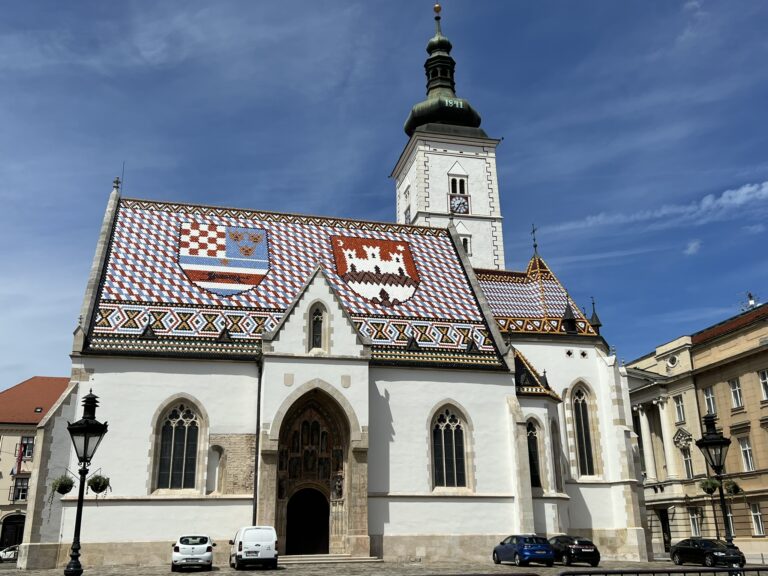

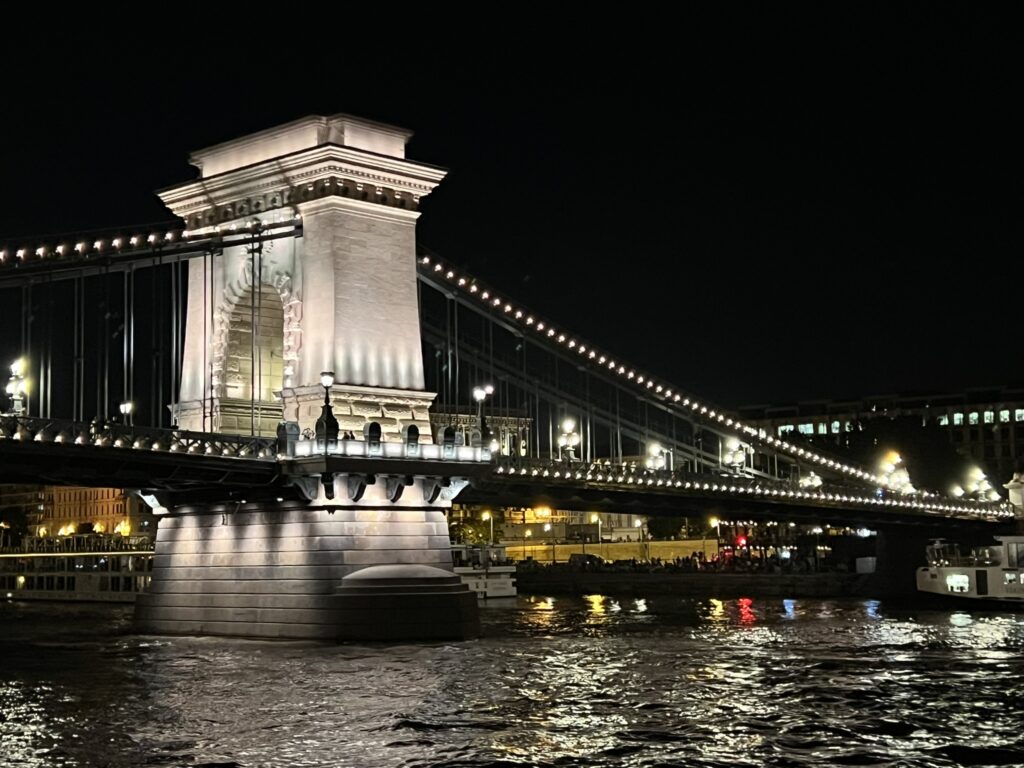
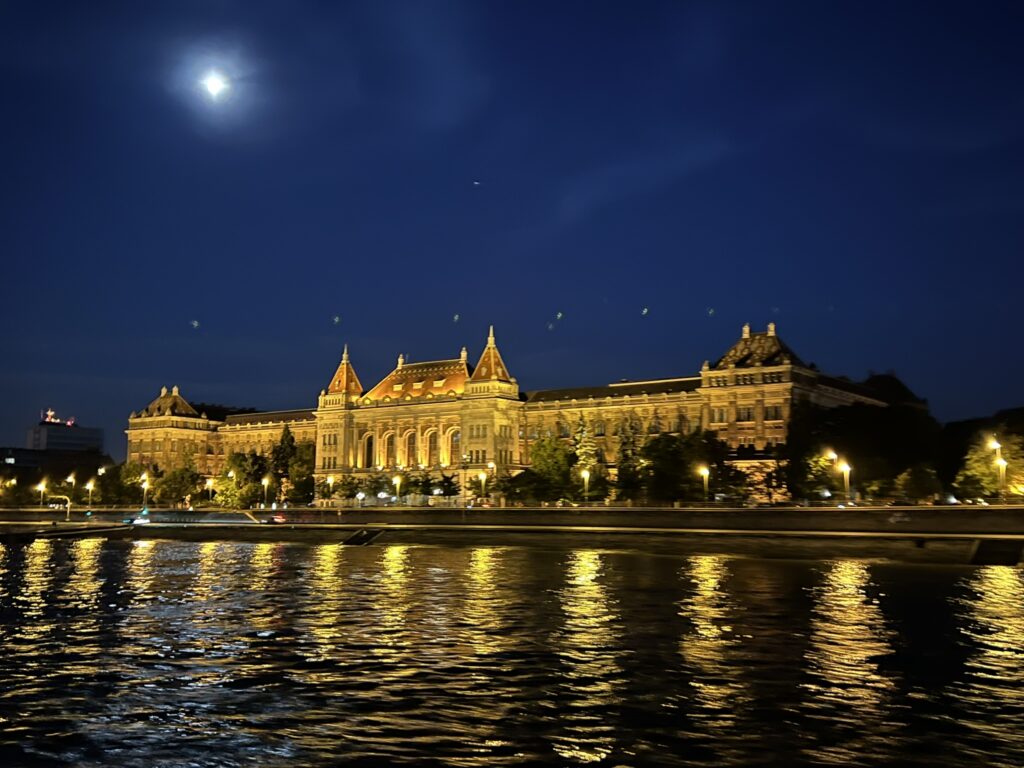
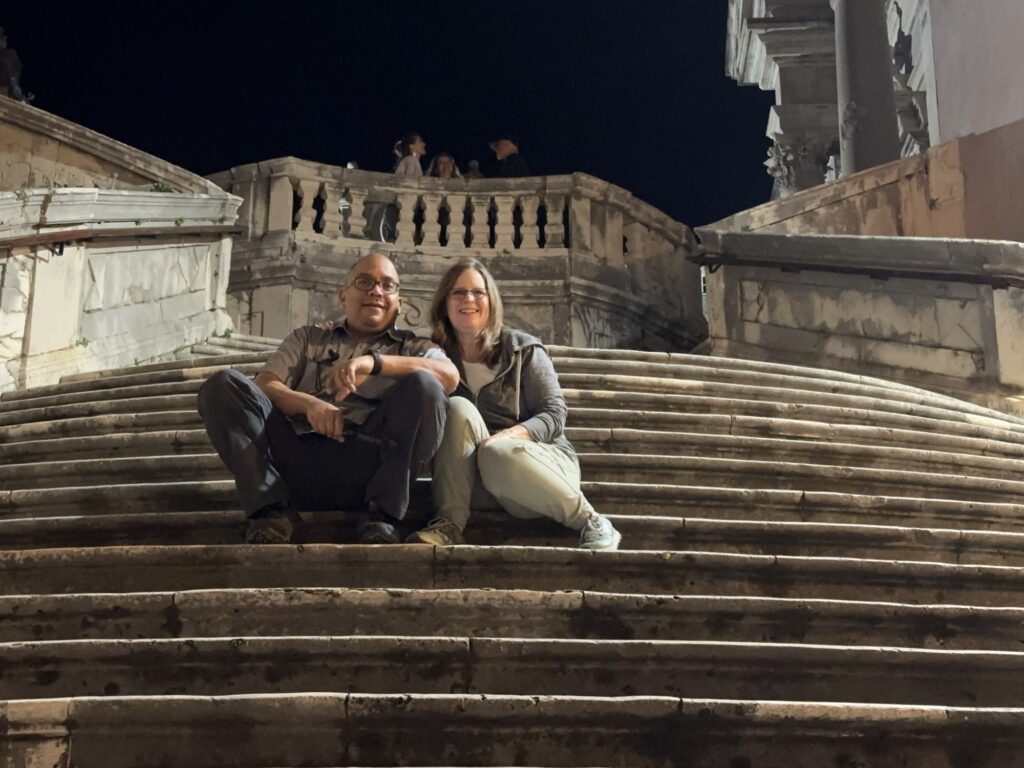

No comment yet, add your voice below!